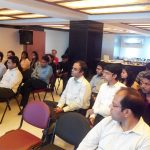- August 21, 2014
- Posted by: kunalsabnis
- Category:BLOG, Events, Kolkata, Speaker Events
Contributed by: Abhishek Shah
Bull markets are often associated with investor mania. At such times, it is easy to catch the frenzy- often to the detriment of our own interests. Much as market discounts the future, investors need to take stock of the current situation and then assess the risks associated with a potential investment idea. IAIP Kolkata was lucky to host Jayanta Roy, SVP, ICRA Limited, who has extensively covered India’s Iron & Steel sector. He apprised the audience about the various bottlenecks that the sector is currently facing- from macro issues and raw material accessibility to company specific factors.
India is the world’s 4th largest steel producing country after China, Japan and USA, and has a current capacity of 96 million MT, with the top 5 players accounting for more than 50% of the total capacity. Sluggishness in key end-user industries continued during FY14, leading to the domestic steel consumption growing by a meager 0.6%. Demand outlook from construction sector remains muted. While some recovery was seen in the auto space, the same was uneven- two wheeler productions looked up but commercial vehicles saw a decline. Steel sector is also likely to face pressure from a stronger rupee and lower international prices. On the raw material side, iron ore production has been falling and the outlook remains uncertain given the state of mining clearances.
The plight of the sector has been compounded by the fact that companies went after debt funded capacity expansion aggressively, resulting in leveraged balance sheets. They now find their repayment burden coinciding with the economic downturn. The grim situation is best highlighted by the fact that the steel sector has the second highest share in CDR. Despite the near term grim outlook, the speaker remained more optimistic about the medium to long term prospects for the industry given factors such as gap in infrastructure, prospects of India becoming an auto hub, etc.
In the second part of the presentation, Jayanta spoke about the corporate credit quality in India. Corporate credit as a % of GDP is at relatively reasonable levels in India and has remained fairly stable over the past few years. However, there is a considerable credit gap in the MSE segment.
The amount of stress in Indian corporate balance sheets is evident from the fact that ~25% of listed entities in India have interest cover of less than 1x. Increasing number of cases are being referred to the CDR cell. However, Inverse Credit Ratio (ratio of downgrades to upgrades) declined to 1.1 during 2013-14 from exceptionally high levels of 3.4 in 2012-13 and 2.6 in 2011-12. Stretched working capital cycles or cash flows, demand slowdown and pressures on profitability were the key reasons for downgrades in 2013-14, accounting for ~43% of the total downgrades. Gradual improvement is further expected in the current fiscal.
The event was an eye opener at a time when the markets and investors are thriving on optimism. The audiences were in much better shape to understand the underlying currents in the economy and the pressure points that need to be addressed before positive results can be expected.
– AS




